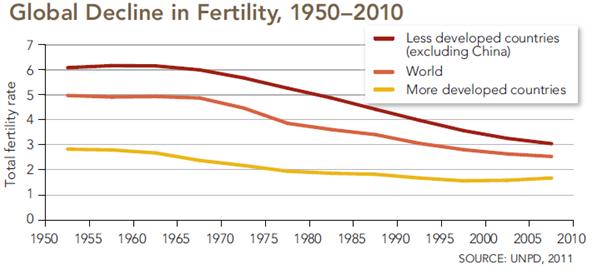Noah Smith wrote an article in Bloomberg about how to convince the Japanese to have more kids:
Japan would like to stabilize its rapidly aging population, and there are really only two ways to do that. It can let in tons of immigrants, or it can find some way to raise fertility. Otherwise, it had better resign itself to decades of sluggish economic growth, as hard-working young people are required to carry a larger and larger pyramid of retired old people on their backs. Its social security system will go bankrupt, the health care system will struggle, and interest rates might stay at zero permanently.
We have covered this issue earlier. Here is how Jim Foreit concluded his guest blog (January 14, 2014):
Half of the countries worldwide now have sub-replacement fertility. The downside to this trend is shrinking labor forces – a factor which has led some governments to try to reverse the course and increase fertility. Romania banned abortion, and fertility briefly increased – until illegal sources of abortion appeared to meet demand. Other countries like France and Germany in the 1930s provided families with generous incentives ranging from free childcare to cash payments for additional children, but these actions did not produce substantially higher fertility. The relaxation of China’s one-child policy may result in higher fertility, but the effects will not be known for several years.
A sub-replacement fertility world seems inevitable, with fewer productive adults supporting larger numbers of the elderly. What this will mean for human welfare will depend on both the future productivity of working adults and living the expected living standards for their parents.
I have also posited that money and women’s education are among the best contraceptives. Figure 1 was taken from the special Science magazine issue published when humanity passed the population mark of seven billion.
 Figure 1 – Global Fertility Rates
Figure 1 – Global Fertility Rates
Developed countries as a group are way below the replacement rate fertility of 2.1. In other words, short of increasing fertility, if rich countries wish to avoid the consequences of shrinking populations, they will have to resort to immigration.
This brings us to the important role that immigration can play in mitigating climate change and the related Anthropocene.
The IPAT identity describes the indicators responsible for emission of carbon dioxide. (November 26, 2012):
There is a useful identity that correlates the environmental impacts (greenhouse gases, in Governor Romney’s statement) with the other indicators. The equation is known as the IPAT equation (or I=PAT), which stands for Impact Population Affluence Technology. The equation was proposed independently by two research teams; one consists of Paul R. Ehrlich and John Holdren (now President Obama’s Science Adviser), while the other is led by Barry Commoner (P.R. Ehrlich and J.P. Holdren; Bulletin of Atmospheric Science 28:16 (1972). B. Commoner; Bulletin of Atmospheric Science 28:42 (1972).)
The identity takes the following form:
Impact = Population x Affluence x Technology
Almost all of the future scenarios for climate change make separate estimates of the indicators in this equation. The difference factor of 15 in GDP/Person (measure of affluence), between the average Chinese and average American makes it clear that the Chinese and the rest of the developing world will do everything they can to try to “even the score” with the developed world. The global challenge is how to do this while at the same time minimizing the environmental impact.
I showed the identity’s various indicators’ contributions to carbon dioxide emissions in a blog (February 24, 2015) about energy transition in India. Figure 2 shows the evolution of these contributions.

Figure 2 – Decomposition of the change in total global CO2 emissions from fossil fuel combustion by decade (IPCC Fifth Assessment Synthesis Report)
Currently (2001 – 2010), the global upsurge in the standard of living, (expressed as an increase in the GDP/Capita) is the main leading indicator of rising emissions. The second best indicator of rising emissions is population growth. Going back to Figure 1, the most effective way to regulate population growth is to increase in GDP/capita. From there, we reach the hypothesis that immigration from poor countries to rich ones is perhaps the most efficient way to regulate both the global population growth and the rise in emissions. Immigrant families usually achieve the lower fertility rates of the host countries within one generation. The influx of new residents would balance the declining populations of developed countries. Poor developing countries, whose fast increase in global GDP/capita has been mirrored by quickly escalating emissions, would meanwhile support fewer people and thus emit less. Attempts to block immigration ensure that rich countries will suffer economic stagnation, poor countries will continue to founder in the misery of poverty. Illegal attempts to block immigration not only reduce global security but also impair efforts to fight international threats like climate change.
